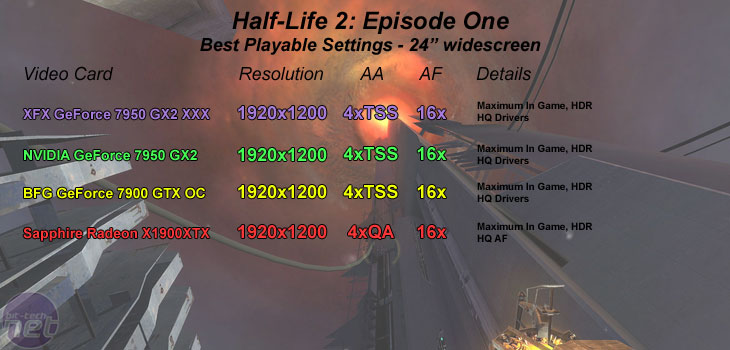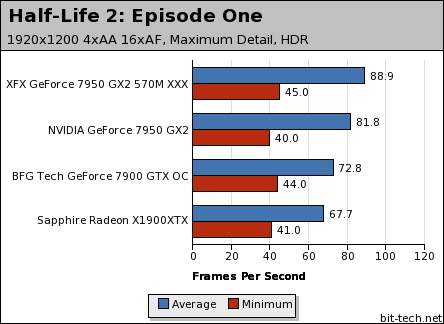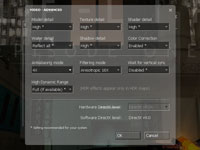For gameplay evaluations on a CRT, please head back to our CRT performance section.
Half-Life 2: Episode One is the first in a series of episodes that extends the Half-Life 2 story far beyond where the original left off. Valve has implemented its high-dynamic range rendering and used it to great effect in Half-Life 2: Episode One. There are new higher-resolution textures, new facial animations and some AI improvements made in the new game too.
Anti-aliasing and anisotropic filtering were controlled from inside the game, and thus the drivers were left set to "Application Controlled". There are three options for the method of HDR used in this title. You can either disable HDR completely, make use of "Bloom" which is just what it says and less resource hungry in comparison to "Full" which, again is just what it says. It utilises a full dynamic range with the iris effect too.
We have written quite a bit about Half-Life 2: Lost Coast, Day of Defeat: Source, Episode One and how Valve have implemented HDR in to the Source Engine. You can check out the articles listed below for more information on The Lost Coast & Day of Defeat: Source.
We did a five minute manual run through from the Exit 17 level. It involves lots of HDR, lots of explosions and both indoor and outdoor scenes. The section we have used is typical of some of the more stressful areas in the game. Thankfully though, the game runs superbly on a wide range of hardware, while still looking absolutely stunning.

 With a resolution increase, you would expect a massively increased gameplay advantage on faster video cards. However, in Half-Life 2: Episode One, the GeForce 7950 GX2's were stuck in a bit of a hole. Neither the reference-clocked cards or the pre-overclocked XFX 570M XXX Edition card were able to attain smooth gameplay at 1920x1200 with more than 4xAA enabled.
With a resolution increase, you would expect a massively increased gameplay advantage on faster video cards. However, in Half-Life 2: Episode One, the GeForce 7950 GX2's were stuck in a bit of a hole. Neither the reference-clocked cards or the pre-overclocked XFX 570M XXX Edition card were able to attain smooth gameplay at 1920x1200 with more than 4xAA enabled.
We tried playing the game with 8xAA, without transparency supersampling enabled, and found that the frame rate was often dropping down to 20 frames per second. The reference-clocked GeForce 7950 GX2 was very choppy with 8xAA applied. Even though the gameplay was not incredibly choppy on the XFX GeForce 7950 GX2 570M XXX Edition, it wasn't delivering a smooth enough frame rate - there were far too many occasions where the frame rate was below 30 frames per second.
Instead, we settled for 4xAA with transparency supersampling enabled and maximum in game details. These were the same settings that we found playable on the GeForce 7900 GTX OC and Radeon X1900XTX. We can't help but feel that there is the processing power available to play the game at 1920x1200 with 8xAA, the cards are just crying out for more memory bandwidth.
 The XFX GeForce 7950 GX2 570M XXX Edition is slightly faster than the reference clocked GeForce 7950 GX2, as one would expect - the performance gap is similar to what we saw at 1600x1200. The gap between the GeForce 7950 GX2's and the BFG Tech GeForce 7900 GTX OC and Sapphire Radeon X1900XTX increases slightly, but the minimum frame rate remains more than acceptable at these settings.
The XFX GeForce 7950 GX2 570M XXX Edition is slightly faster than the reference clocked GeForce 7950 GX2, as one would expect - the performance gap is similar to what we saw at 1600x1200. The gap between the GeForce 7950 GX2's and the BFG Tech GeForce 7900 GTX OC and Sapphire Radeon X1900XTX increases slightly, but the minimum frame rate remains more than acceptable at these settings.
Half-Life 2: Episode One
Publisher: Valve SoftwareHalf-Life 2: Episode One is the first in a series of episodes that extends the Half-Life 2 story far beyond where the original left off. Valve has implemented its high-dynamic range rendering and used it to great effect in Half-Life 2: Episode One. There are new higher-resolution textures, new facial animations and some AI improvements made in the new game too.
Anti-aliasing and anisotropic filtering were controlled from inside the game, and thus the drivers were left set to "Application Controlled". There are three options for the method of HDR used in this title. You can either disable HDR completely, make use of "Bloom" which is just what it says and less resource hungry in comparison to "Full" which, again is just what it says. It utilises a full dynamic range with the iris effect too.
We have written quite a bit about Half-Life 2: Lost Coast, Day of Defeat: Source, Episode One and how Valve have implemented HDR in to the Source Engine. You can check out the articles listed below for more information on The Lost Coast & Day of Defeat: Source.
- Half-Life 2: Lost Coast HDR overview
- Half-Life 2: Lost Coast hands on
- Half-Life 2: Lost Coast Benchmarks & Video
- Day of Defeat: Source
- Cinematic Effects in Source
- Liveblogging HL2: Episode One
We did a five minute manual run through from the Exit 17 level. It involves lots of HDR, lots of explosions and both indoor and outdoor scenes. The section we have used is typical of some of the more stressful areas in the game. Thankfully though, the game runs superbly on a wide range of hardware, while still looking absolutely stunning.


We tried playing the game with 8xAA, without transparency supersampling enabled, and found that the frame rate was often dropping down to 20 frames per second. The reference-clocked GeForce 7950 GX2 was very choppy with 8xAA applied. Even though the gameplay was not incredibly choppy on the XFX GeForce 7950 GX2 570M XXX Edition, it wasn't delivering a smooth enough frame rate - there were far too many occasions where the frame rate was below 30 frames per second.
Instead, we settled for 4xAA with transparency supersampling enabled and maximum in game details. These were the same settings that we found playable on the GeForce 7900 GTX OC and Radeon X1900XTX. We can't help but feel that there is the processing power available to play the game at 1920x1200 with 8xAA, the cards are just crying out for more memory bandwidth.
Apples to Apples - 1920x1200 4xAA 16xAF


MSI MPG Velox 100R Chassis Review
October 14 2021 | 15:04







Want to comment? Please log in.